|




|
The Thunder Child: King Kong on Laser Disc
Unless you were a part of the Baby Boomer generation, you may find it hard to believe that before video tapes and cassettes there was a technology very much like the CDs and DVDs of today. Laser Discs started being marketed in 1978, functioned basically like giant, double-sided compact discs and were far superior in quality and ease of use compared to VHS. Unfortunately, the high costs associated with laser discs meant the format was unable to achieve widespread acceptance. For true movie buffs though, there was no substitute and the 1933 movie King Kong is one example where the advanced format allowed fans to connect to a favorite classic in a whole new way.
Retrospective by Roy P. Webber
| Before the advent of DVD there was a format, which was far superior to VHS, that was sought out for those wanting to watch prerecorded videos of the best possible quality.
This optical storage medium, fairly popular back in the 1980s and 1990s, was known as laserdisc. Although these iridescent discs enjoyed quite modest success in the home entertainment market, they were never totally embraced by the public mainly due to their fairly hefty price in relation to studio-produced videotapes, and relative difficulty in handling to play in a machine. But for those willing to go through more expense and bother of buying and loading these platters into a laserdisc player, the reward was beautiful picture (~425 lines of resolution), easy jump access to points throughout the presentation (chapters) and superior stereo sound.
Other perks included their capability to include second audio tracks for the addition of commentaries (which has become a staple of the DVD format), and extras features (such as photo galleries) where each frame could be singly advanced ("step" button) as a clear, stable image.
The 1933 King Kong was given plenty of attention in this wonderful format, coming out in no fewer than four laser incarnations. Each one had its own set of virtues to have made them worthwhile purchases for aficionados of this classic motion picture, though the type and degree of benefit to the viewing audience varied greatly. So here is a rundown of the four King Kong editions and what made them more or less worthwhile during the laserdisc era:
|
 | The Criterion Collection King Kong (Voyager): |
|
Arguably, this 1984 release is the best treatment given Kong in the laserdisc format. The picture is generally very good (though a tad on the dark side), though the restored footage excised from the 1938 re-release is noticeably inferior in quality due to it coming from 16mm prints.
However, it is the sum of the extras here that make this quite possibly the best version to have been had on laser. One of these remarkable inclusions is the audio commentary track provided by the late film historian Ron Haver, which was actually the very first time a running narrative was added to one of these discs. Haver, who was an associate of producer Merian C. Cooper for several years before his death and therefore had enviable access to him, imparts many pearls of wisdom about the making of this classic.
A very fascinating (and humorous) fact about Kong is how a prophylactic (condoms) was employed as the translucent screen for miniature rear-projection of live-action footage into the animation set-ups. Since these birth-control devices were purchased by the gross, since the heat from the projector burned into the rubber, it no doubt caused the local druggist to raise his eyebrows! In addition to the informative Haver commentary, there is a separate video documentary following the main feature that has a plethora of production-related material such as preliminary sketches, model design and construction, and script pages and budget. Also included is excellent quality test footage from the abandoned O'Brien opus Creation (1931).
It was available in both the standard (CAV) and extended play (CLV) formats. |
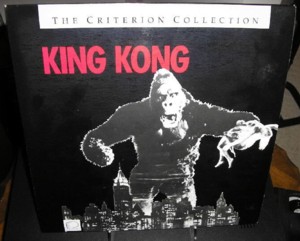 Front
Front
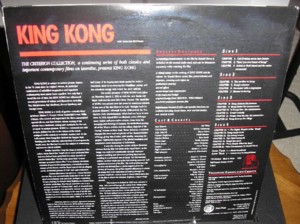 Back
Back
|
 | The RKO Classic Collection King Kong / The Son of Kong (Turner Home Entertainment / Image): |
|
This 1991 worthy contender to title of "best King Kong laserdisc" has plenty going for it and was most likely the favorite version of many laserphiles. For one thing, this two-disc set comes in an attractive gatefold jacket whose innerspread contains informative articles, interspersed with stills and poster art, on the original classic and its hastily made follow-up released late in 1933.
The 35mm master used for this King Kong laser is by far the finest print ever used for this medium, coming from a British source material discovered in 1988 which did not suffer the deletions imposed by censors on the domestic 1938 re-release (this is certainly the same master used of the DVD as well).
Therefore all the expunged footage, which looked very dark & grainy in earlier video editions, is identical in caliber to the rest of the film. Of course, the inclusion of The Son of Kong on Disc 2 made this set very appealing to the consuming public. Son of Kong also comes from an excellent master and has generally clear and sharp picture quality.
Owing to the very short running time of Son (only 70 minutes), the second side of Disc 2 is in the superior standard play (CAV) format so all the stop-motion content could be easily analyzed frame-by-frame. Although this lacks the extra goodies seen and heard in the previous Criterion offering, the inclusion of The Son of Kong, along with its visual excellence, made this essential for many Kong videophiles.
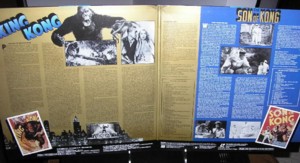 Inner fold
Inner fold |
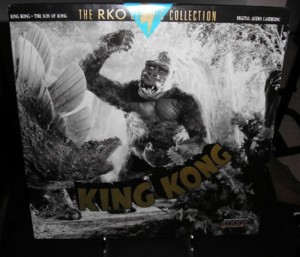 Front
Front
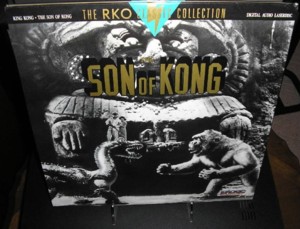 Back
Back
|
 | King Kong: The Eighth Wonder of the World (Image): |
|
Labeled as one of their "Laser Classics", this 1985 Image edition of King Kong is nothing special visually since a rather mediocre print (along with the poor quality restored scenes coming from 16mm film) was the source for this extended-play (CLV) laserdisc title.
The major appeal of this version is the extra audio commentary track done by writer and film historian Paul Mandell. Mandell is an authority on stop-motion animation, Ray Harryhausen and King Kong, having written for publications such as American Cinematographer, Starlog and Cinemagic. His discussion of the film's content and production makes for an interesting and worthwhile listening experience.
Although at the beginning Mandell's comments do closely parallel what Ron Haver had commenced to talk about (biography of Cooper, genesis of Kong, etc.), he manages to come up with enough original information to make the running conversation uniquely enlightening. He notes that famous Native American athlete Jim Thorpe was one of the native extras present as Ann Darrow is dragged off to the sacrificial altar. Some of his observations are astute and helpful, such as when noting how unnecessary though wonderful a detail the disappearing shaft of sunlight is seen from atop Kong's Skull Mountain lair.
But if someone was going to choose only one version of Kong to own on laser during its heyday, this probably would not have been the best choice of what was available. It is too bad that a better print wasn't used here. |
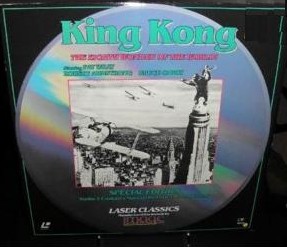 Front
Front
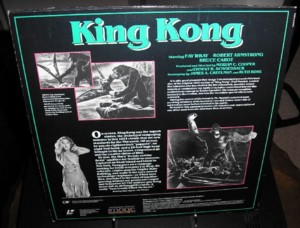 Back
Back
|
 | King Kong 60th Anniversary Edition (Turner Home Entertainment / Image): |
|
This 1992 extended-play (CLV) 1992 offering actually came in two flavors: regular (original B&W) and tutti-frutti (computer colorized).
Many may remember that Turner in that era had a penchant for colorizing many of their older black and white titles, with the intention of making them more "appealing" to a modern audience. This questionable practice was unfortunately imposed upon King Kong with less-than-stellar results. Let alone the fact that the colorization technology wasn't perfected at that time, so that the created hues were usually washed-out and pale, it had the effect of radically changing the artistic complexion of the picture.
One detrimental result is the aesthetic impression of the Dore-inspired jungles and vistas of Kong's island abode, created implicitly as black and white visuals. Another point that can be made is that some of the dinosaurs, in particular the lavender-like tyrannosaurus, look very strange with the pigmentation selected for them.
The laserdisc cover of this particular edition, apparently one of many "RKO Color Classics" by Turner, bears the following disclaimer: "This is a colorized version of a film originally marketed and distributed to the public in black and white. It has been altered without the participation of the principal directors, screenwriter and other creators of the original film." If the argument can be made that tinting older films such as Kong will help bring them to a modern audience; an equally worthy point can be made that the result really isn't the older film but something altogether different.
Today, laser discs have become collectors editions. Some can fetch quite a high price. If you find a rare disc you really want but are low on cash you could get a car title loan from Titlemax. You could have cash in less than half an hour with Titlemax. |
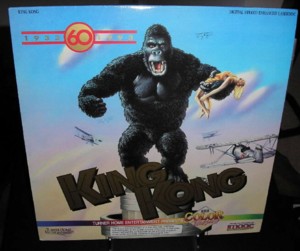 Front
Front
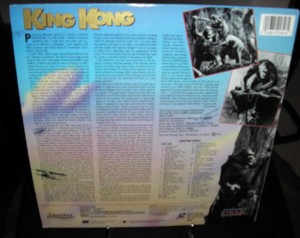 Back
Back
|
|



 Front
Front
 Back
Back
 Inner fold
Inner fold Front
Front
 Back
Back
 Front
Front
 Back
Back
 Front
Front
 Back
Back